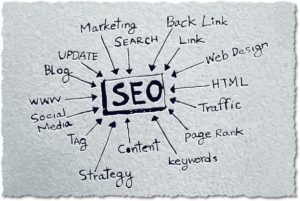SEO and the New Era in Inbound Marketing

SEO, or Search Engine Optimization, is the top topic on marketers minds for the second year in a row according to Hubspot’s recently published report The State of Inbound 2016. The report is teeming with insightful data. In this blog post, we’re going to focus on the SEO component of the report, and why it is on the top of the list for the second year in a row.
Specifically, the report cites “Growing SEO/Organic Presence” as the top priority. This is a big topic, and one that can’t be covered or solved in a single post. But the bottom line of this stated goal references the importance of, and value in, good relevant content.
Simple enough. But we left off an important part of that last sentence to repeat it here for emphasis. The goal references the importance of, and value in, good relevant content that people consume and engage with. This last part is the flash point for success in a content marketing strategy. Remember the old saying, “If a tree falls in the forrest and no one is around, does it still make a sound?”
Extrapolate that to reference content: If you produce and post a killer blog post (or video) and no one sees it, does it matter? Of course not. This is because communications — as in Marketing Communications — by nature requires a sender, and a receiver. It’s easy to forget sometimes that our marketing communications work must be first, received, and second, create an action, whether that’s in the form of changing perceptions, creating awareness, or driving a sale.
Now, let’s circle back to the topic of SEO.
We’re in a publishing-centric world, brought about by the disruption the Internet has created for media players of all shapes and sizes. Today, because of the power of SEO and share-ability, a blogger working from his/her bedroom in rural Idaho can have as much influence on an audience as a major network or news channel.
The power behind this level of dynamic content (besides passing the first test of being relevant and well-crafted) is SEO – the ability to utilize the infrastructure of the social web, largely driven by the power of Google search, to bypass traditional distribution channels and gain visibility according to relevance. And the power of SEO is not going to diminish, at least in the near term.
Here are a few reasons why:
- More and more people will rely on search criteria to find the content they want. This trend will largely be driven by millennials and the younger generation, to whom the phrase “early adopter” means nothing. This audience has grown up with digital technology, and it’s second nature for them to use search to find what they want.
- As broadband accessibility widens, more and more searches will be performed. Companies like Google and Facebook are quietly working to build out widespread accessibility to the Internet. This effort is both self-serving and universally positive. Add to that the freedom that driverless cars will bring, allowing more people to search for and consume content during a commute.
- The growth in alternative search tools. Google will likely retain its lock on web-wide organic search, but subcategory search methods such as digital assistants (think Siri or Alexa) and store-based search engines, like those found on Amazon.com and YouTube will continue to grow in use and influence.
- The diminishing of traditional advertising. While traditional (print) advertising is still being utilized by some companies, the growing demand for ROI for awareness marketing (along with the viability of measurement potential that digital marketing brings) will eventually edge out traditional advertising. The monies budgeted for traditional advertising will not go away. These budgets will shift to alternative forms of inbound marketing that are SEO-centric.
- Increasing sophistication of SEO marketing. Old school techniques like keyword stuffing and cheap link building approaches are going away. Marketers are increasingly finding new and more sophisticated ways to enhance awareness and inbound marketing efforts, and these tools are becoming more prevalent and more affordable.
The trend towards SEO in inbound marketing will continue to build. If your company is not focused on adding SEO, or increasing SEO efforts, you’ll find yourself quickly outpaced against your competitors.
If you would like to discuss how we can help you build an effective marketing strategy for your brand, service or product, give us a call at (310) 684-3552 or send me an email at the address below.

President Threlkeld Communications
Bill Threlkeld is the president of Threlkeld Communications, a marketing communications and public relations firm that helps businesses develop the right marketing strategies to grow their businesses and meet financial goals. He can be reached at [email protected]
